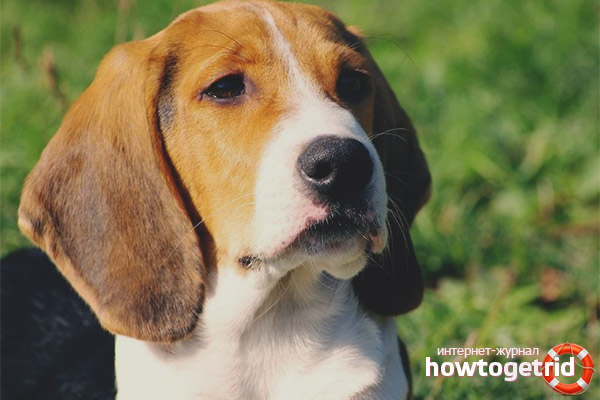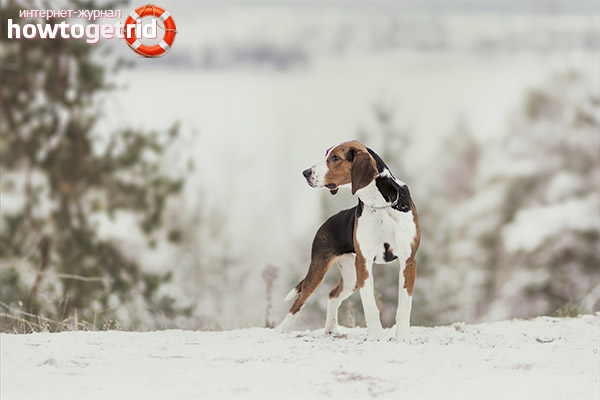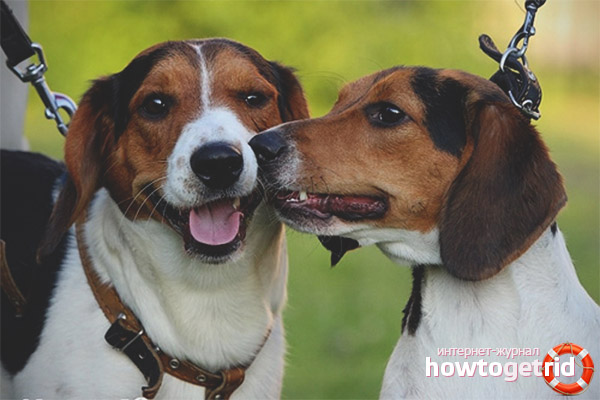The content of the article
The Finnish hound means a three-colored breed, which in the open spaces of its homeland is called Suomenayokoira. It is difficult to pronounce, but there is no particular need for this. Dogs are famous for their melodious voice, when they drive game, they can give special signals. Thanks to this, the hunter himself and the "relatives" of the dog successfully complete the action. But first things first.
Historical data
- Based on the common name, it is clear that dogs originated in Finland. The breeder who created the first representatives of the breed was previously a jeweler and a blacksmith in one person. An interesting fact that explains with what jewelry accuracy he picked up the features and external data of animals.
- There are many versions that affect historical origin. According to some reports, the dog turned out like this because the best hounds with hunting qualities were selected for crossbreeding. Another theory says that the ancestors of the Finnish breeds were crossed with other hounds, arriving in Finland from around the world. According to the third theory, the Foxhounds were crossed with existing hounds, so they got the first individuals.
- Who to believe is not clear. But one thing is certain - the Finnish hound contains all the features of a real hunter, leader, family friend. The gene pool of this breed concentrates the positive aspects of all varieties of hounds.
- At the beginning of the 19th century, the Finnish hound was already quite firmly entrenched in Finland. A negative feature of the breed can be called its inability to hunt in the winter (and cold) season. Dogs are more often hired in the summer, spring, and early fall.
- Today, this drawback is not so significant, because a person can already exist without hunting. However, when the breed was just in its infancy, and at the same time it had to take a vacation from hunting for 7-8 months, this was considered a significant problem.
- Probably, for the above reasons, today a dog from Finland is more widespread not in his homeland, but in warmer regions. Finns are small in number, but in popularity can compete with their counterparts.
- Representatives of the breed are famous for their ability to drive hares and foxes, they quickly find prey, lead it. They can smell even after 12 hours. The external and official qualities of dogs were appreciated in 1870 at the largest exhibition of the international standard.
- The amateur club began to develop skills, they took the Finn with them when they went trotting, elk, roe deer, etc. The hunters were pleasantly surprised at the speed with which the dog helped them with such hard work. The breed was officially recognized as unique and independent in 1985.
External characteristics
- According to its external data, the dog completely coincides with other similar "working" breeds. The case is rectangular, the body is tightened, slightly dried. Average growth, well-developed muscles, strong backbone.
- If you evaluate the representatives when they are in the rack, you can understand that the hind legs are very strong. It's all about the lowered croup and its power. The chest is voluminous, the lungs are deep, so the dog can work loudly and to exhaustion.
- In terms of size, bitches differ from males, but it cannot be said that gender superiority is at a high stage. In terms of height, the female sex is 43–49 cm, the male is slightly larger, 45–53 cm.
- The body weight of the dog is not tied to gender, it varies depending on the age, activity and nutrition of the pet (from 20 to 25 kg.).According to the body stretch, females are characterized by indicators of 110-113 cm, males —108-110 cm. It is worth remembering that for the female it is extremely undesirable to have too short physique, otherwise the offspring will not be able to fully eat due to lack of access to the nipples.
Breed standards
- Head. It has the format of a rectangle, not weighted, medium in length, the silhouette is clearly pronounced. The frontal part is not too long, rounded, flows into the muzzle without sharp jumps. The arches around the eyes are clearly visible, which allows us to identify the place of transition of the frontal part to the muzzle. The nose is straight. The lips are pigmented in the color of the coat or black, pressed to the jaws.
- Eyes. They are famous for their almond shape, which makes the dog look cute. The eyes are well expressed, in size with the head they look harmonious, the incision is slanting. The eyelids do not hang, but are pressed tightly. They are brownish or black in color. The irises are bright, saturated, preferably brown or so shades.
- Muzzle. Proportional to the head, with a straight nose bridge, black pigmented large nose. The nose itself is mobile, sensitive. The color may be brownish or black. The teeth are firmly set, large, fully loaded. The bite is correct.
- The ears. Widely planted, located at the level of the orbits. Cascading, not too thick and soft. They can be mobile in the base area, but never stand up. At the ends are rounded, adjacent to the head. It is not permissible for the ears to be covered with folds or a long coat of wool.
- Tail. Planted not high, is at back level and is its continuation. Thick at the base, tapering slightly towards the tip. When the dog is agitated or playful, the tail rises, saber-like. Slight bending is allowed, but not torsion.
- Limbs. With powerful joints, thick bone tissue, developed muscles. Oval in shape. The forelimbs are longer than the hind limbs, straight and parallel to each other. By side view, the individual should not look like a dwarf with short legs, rather, the length of the limbs is approximately ½ of the size from the floor to the withers. The muscles of the hind limbs are dried, the paws themselves are thicker than the front. They are straight and slightly shorter, slightly flattened.
- Body. The dog is average in physique, respectively, the body should look harmonious. The dog is well-built, lean, muscular. The body does not look heavy and weighty, and it is not. The skin does not sag, fits snugly enough, folds are unacceptable. The withers are clearly visible, it is muscular and developed. The chest of a decent volume and size has a rounded shape. The back is even, flows into a powerful lower back and a rounded muscular croup.
Color and type of coat
- Initially, the breed was bred for hunting in the warm season. The dog was supposed to be resistant to heat and heat. The skin of the animal is tight to the body. Folds are completely absent. As a result, the streamlining of the body remains at its best. Air easily glides over the animal while running.
- The presented breed has practically no undercoat. In this case, the outer hair is shiny, even and has medium stiffness. The coat throughout the body is short, on the tail slightly longer. Due to this feature, the tail seems massive. Wavy and long hair is uncharacteristic for the breed. This is considered a deviation from the norm.
- The most popular color of the breed is the three-color range. Shades can be white, black or red. The breed standard does not govern the shape and size of spots. Also, the saturation of their color is not taken into account. The Finnish hound has other colors.
- Among those, most often is black-frotted or tricolor. Which may include red, crimson, brown or white.It is worth noting that when evaluating the breed, the compatibility of the pigmentation of the lips, eyelids and nose lobe with the color of the pet is taken into account.
Training and character
- In most cases, the breed in question is quite friendly, responsive and flexible. Thanks to thoroughbred qualities, hounds become excellent companions in sports.
- However, there are subtleties. Despite the soft nature of the dog, training is not easy. With the presented breed, you need to be strict, persistent, restrained and persistent. Such dogs have difficulty mastering various teams. It is extremely difficult to call a pet to yourself.
- The problem is that the hound begins to get carried away quickly by the pursuit or the game. If the puppy’s genus was specifically working individuals, then it can be said with accuracy that the dog will not respond to your commands. Such an animal is inclined to make decisions on its own. The working hound has its own opinion.
- As soon as the dog begins to grow up, be prepared for the fact that she will begin to try to take a leadership position. This desire must be suppressed. Separately, it is worth noting that the leader of the pack has restraint and nobleness. If you punish and scream at the pet, nothing good will come of it.
- The Finnish Hound cannot be trained in classical ways. Habitual exercises quickly annoy the animal. Training must be combined with long and very energetic games. In the initial stages of education, do not let the puppy run ahead of you.
- Thus, even at an unconscious age, the dog is trying to dominate you. Adults will always be stubborn when training. Therefore, education should occur as early as possible.
- In this matter, you need to find the right motivation and clearly prioritize. For the usual bribes, such dogs will not follow your orders. Promotions must be truly valuable. It is for this puppy that due attention must be paid. A close relationship and close relationship should be established between you.
Care and maintenance
- Separately, it is worth mentioning that the Finnish hound is not suitable for keeping in an apartment. The pet needs free space and very active walks. An excellent alternative would be a private house with a decent area of the adjacent plot.
- Do not forget that the dog belongs to the hunting breed. That is why it is necessary to run along the steppe or forest with the pet. The dog must look for other animals. This is the best thing for her. If you do not fulfill such needs, the pet will constantly experience tremendous stress.
- As a result, a severe psychological state negatively affects the general well-being of the animal and its character. Also, active walks are strongly recommended to be carried out in a circle of relatives. Hounds love massive games and entertainment. As for leaving, you will not have any particular difficulties.
A distinctive feature of the Finnish hounds is the fact that with them you can walk on any animal or bird. Dogs do not work except in winter, for unknown reasons. These are great companions that get along with humans and other animals.
Video: Finnish and Bulgarian Hounds












Submit